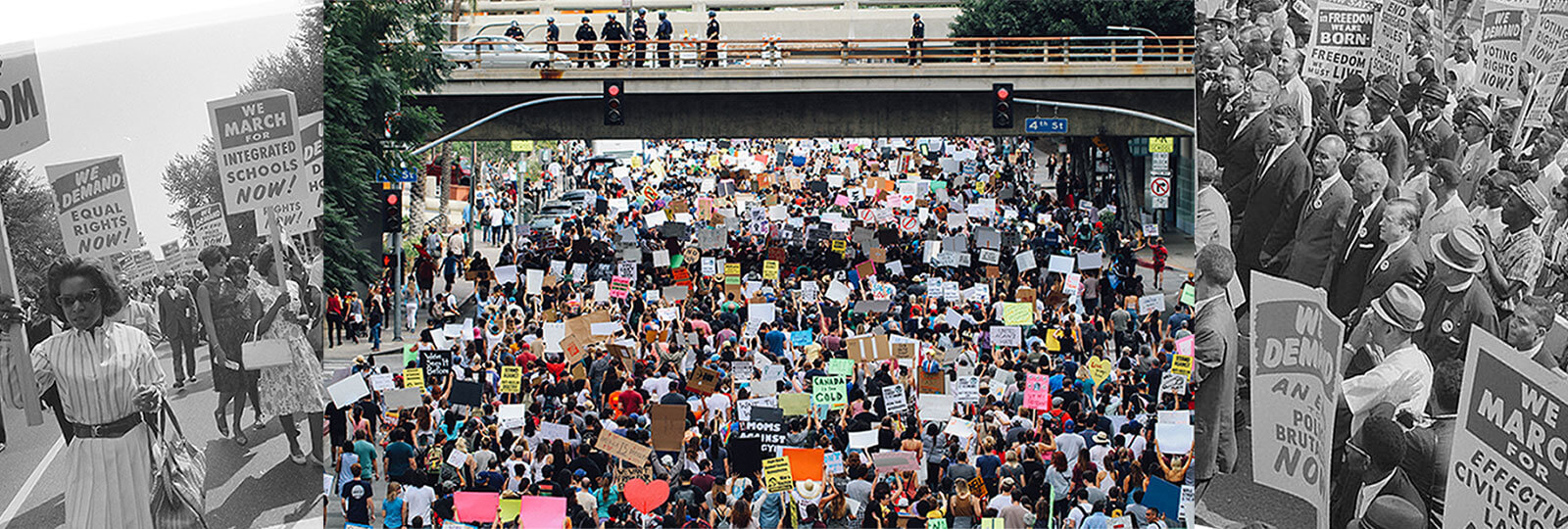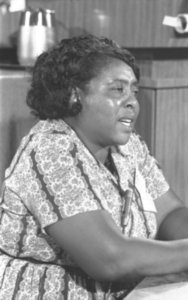

Alex Radelich/Unsplash, Public Domain/Library of Congress
Explain This
Alex Radelich/Unsplash, Public Domain/Library of Congress
There’s Nothing More American Than a Protest
The constitutional scholar and author of 'The Bill of Rights: A User's Guide' reflects on the legacy of Fannie Lou Hamer and the way social movements of today reflect the history—and necessity—of civic activism.
This article was made possible because of the generous support of DAME members. We urgently need your help to keep publishing. Will you contribute just $5 a month to support our journalism?
Consider ours the #HashtagDemocracy, in which millions of people can be mobilized to take action in seconds—with a phrase, a photograph, a meme. #BlackLivesMatter shone a piercing light on the deaths of Black people at the hands of police. The #WomensMarch mobilized millions nationwide to protest the inauguration of a president who disrespected women, and #MeToo created a tsunami of change about sexual harassment in the workplace. #NeverAgain defied the juggernaut of the National Rifle Association to demand reasonable gun control to save lives. Thomas Paine never had it so good. We are living in a golden age of civic activism.
During the throes of World War II, Judge Learned Hand of New York emphasized the necessity of such civic movements to the survival of freedom. In his famous “Spirit of Liberty” address, given at a naturalization ceremony in Central Park, Judge Hand stated:
“I often wonder whether we do not rest our hopes too much upon constitutions, upon laws and upon courts. These are false hopes; believe me, these are false hopes. Liberty lies in the hearts of men and women; when it dies there, no constitution, no law, no court can even do much to help it.”
We live in times such as these, when the limits of our institutions and the rule of law are sorely tested. Of course, for many Americans the promises of the Constitution and the Bill of Rights have too often been hollow. Yet what inspires me as a constitutional scholar is how often the people who were told they weren’t included in “We the People” just refused to believe it. Over and over, their voices ring throughout American history with lessons for today. Our ancestors plowed the row for us to follow.
Women have often been at the forefront of these movements, but are seldom fully recognized. One of the precursors to the American Revolution was the Edenton Ladies Tea Party in North Carolina in 1774. Never heard of it? Well, the London newspapers did and satirized them mercilessly. These 51 women in an Atlantic coastal port issued their own nonimportation agreement to boycott British goods and sent it to the English newspapers for good measure. A cartoonist lampooned them with jabs similar to those aimed at today’s feminists: loose, immoral women who neglected their children. The Edenton ladies represented thousands of women whose actions contributed to the creation of a new republic.
Moreover, in 1777 the slaves of Massachusetts petitioned their legislature for freedom, quoting the Declaration of Independence to support their petition. Yet when the Constitution was written in 1787, slavery was still legal in all 13 states. In an 1857 case brought to free the enslaved family of Dred Scott, including his wife Harriet and his two daughters, the Supreme Court ruled instead that African-Americans, free or slave, could never become citizens under the Constitution. Overturning this case required a Civil War and the 13th and 14th Amendments. In fact, the Supreme Court ruled that corporations were protected by the 14th Amendment before it extended those same protections to African-Americans.
Labor movement protests against corporate interests in the early 1900s gave rise to the First Amendment protections we cherish today. Speaking on street corners was illegal then, to stop union organizing and other protests, but labor activist Elizabeth Gurley Flynn continued to lead the opposition:
“We sent out a call to all footloose rebels to come at once—to defend the Bill of Rights. A steady stream of I.W.W. [Industrial Workers of the World] members began to flock in by freight cars. … As soon as one speaker was arrested, another took his place.”
Finally, in 1939, the Supreme Court struck down such local prohibitions on freedom of speech and assembly. In that case, Frank Hague, the mayor of Jersey City, N.J., had opposed unions: “You hear about constitutional rights, free speech, and the free press. Every time I hear those words I say to myself, ‘That man is a Red, that man is a Communist.’ You never hear a real American talk like that.”
More than a century after the Civil War ended, African-Americans still endured extreme injustice in employment, education, and most of all voting—which was the right needed to achieve all others. In the segregated South, where most African-Americans still lived, the civil-rights movement sought to achieve change despite being blocked by state legislatures and the local courts. Even federal court rulings went unenforced, until a massive outpouring of civic protest—including the violent deaths of civil rights martyrs—confronted the brutality of white supremacy. The #BlackLivesMatter movement continues that struggle today.
One woman in Mississippi, Mrs. Fannie Lou Hamer (as she preferred to be called in an era when whites called African-American adults by their first names), became a national leader in the civil-rights movement. She lived as a sharecropper on a plantation, the youngest of 20 children, until at the age of 44 when she attempted to register to vote for the first time. She failed a complicated test about the Mississippi Constitution that no whites had to take. When she returned, she was fired and forced to leave her husband and family after gunshots repeatedly rang through her home. “What was the point of being scared?” she said later. “The only thing they could do to me was kill me, and it seemed like they’d been trying to do that a little bit at a time ever since I could remember.”

In a famous speech, Mrs. Hamer testified on national television at the Democratic National Convention in 1964 about being put out of her home and beaten for wanting to vote. “Is this America,” she asked, “when our lives be threatened daily because we want to live as decent human beings?” In 1965 she represented an alternate ticket that challenged the all-white Mississippi congressional delegation, but the House of Representatives refused to unseat the white Congressmen.
These examples show that at key times in American history the expansion of liberty depended on the actions of citizens—not just the laws enacted by the legislature and the president or the cases decided by courts. As Judge Hand alluded, our freedoms depend much more for their protection on citizens than on laws and courts and constitutions. That’s why it’s so important for Americans to learn about the history of their rights, how they have or have not been protected by the courts, and how citizens have taken action to secure those rights for themselves and others. Now more than ever, it’s up to everyday citizens to keep the Bill of Rights alive and well.
Linda R. Monk is the author of The Bill of Rights: A User’s Guide” (fifth ed., April 2018), which won the American Bar Association’s Silver Gavel Award, its highest honor for media about the law.
Before you go, we hope you’ll consider supporting DAME’s journalism.
Today, just tiny number of corporations and billionaire owners are in control the news we watch and read. That influence shapes our culture and our understanding of the world. But at DAME, we serve as a counterbalance by doing things differently. We’re reader funded, which means our only agenda is to serve our readers. No both sides, no false equivalencies, no billionaire interests. Just our mission to publish the information and reporting that help you navigate the most complex issues we face.
But to keep publishing, stay independent and paywall free for all, we urgently need more support. During our Spring Membership drive, we hope you’ll join the community helping to build a more equitable media landscape with a monthly membership of just $5.00 per month or one-time gift in any amount.
















































































